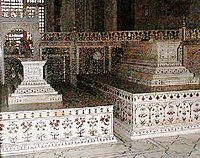Taj Mahal (
, more often
;
[2] from
Persian and
Arabic, "crown of palaces",
pronounced [ˈt̪aːdʒ mɛˈɦɛl]) is a
white marble mausoleum located on the southern bank of the
Yamuna River in the
Indian city of
Agra. It was commissioned in 1632 by the
Mughal emperor Shah Jahan (reigned 1628–1658) to house the tomb of his favorite wife of three,
Mumtaz Mahal.
Construction of the mausoleum was essentially completed in 1643 but
work continued on other phases of the project for an additional ten
years. The Taj Mahal complex is believed to have been completed in its
entirety in 1653 at a cost estimated at the time to be around 32 million
Indian rupees, which in 2015 would be valued at around 52.8 billion
Indian rupees ($827 million US). The construction project employed
around 20,000 artisans under the guidance of a board of architects led
by
Ustad Ahmad Lahauri. The
domed marble tomb is part of an integrated complex consisting of gardens and two
red-sandstone buildings surrounded by a
crenellated wall on three sides.
The Taj Mahal is regarded by many as the best example of
Mughal architecture
and is widely recognized as "the jewel of Muslim art in India". It is
one of the world’s most celebrated structures and a symbol of India’s
rich history. Designated a UNESCO
World Heritage Site in 1983, the Taj Mahal attracts some 3 million visitors a year.
Inspiration
In 1631, Shah Jahan, emperor during the
Mughal empire's period of greatest prosperity, was grief-stricken when his favorite of three wives and beloved companion, Mumtaz Mahal, a
Persian princess, died during the birth of their 14th child,
Gauhara Begum.
[3] Construction of the Taj Mahal began in 1632.
[4] The court chronicles of Shah Jahan's grief illustrate the love story traditionally held as an inspiration for Taj Mahal.
[5][6] The principal mausoleum was completed in 1643
[4] and the surrounding buildings and garden were finished about five years later.
Architecture and design
The Taj Mahal incorporates and expands on design traditions of
Persian and earlier
Mughal architecture. Specific inspiration came from successful
Timurid and Mughal buildings including; the
Gur-e Amir (the tomb of Timur, progenitor of the Mughal dynasty, in
Samarkand),
[7] Humayun's Tomb,
Itmad-Ud-Daulah's Tomb (sometimes called the
Baby Taj), and Shah Jahan's own
Jama Masjid in
Delhi. While earlier Mughal buildings were primarily constructed of red
sandstone, Shah Jahan promoted the use of white marble inlaid with
semi-precious stones. Buildings under his patronage reached new levels of refinement.
[8]
Shah Jahan and Mumtaz Mahal
Tomb
The tomb is the central focus of the entire complex of the Taj Mahal.
It is a large, white marble structure standing on a square
plinth and consists of a symmetrical building with an
iwan (an arch-shaped doorway) topped by a large dome and
finial. Like most Mughal tombs, the basic elements are Persian in origin.
[9]
The base structure is a large multi-chambered cube with
chamfered
corners forming an unequal eight-sided structure that is approximately
55 metres (180 ft) on each of the four long sides. Each side of the iwan
is framed with a huge
pishtaq or vaulted archway with two similarly shaped arched balconies stacked on either side. This motif of stacked
pishtaqs
is replicated on the chamfered corner areas, making the design
completely symmetrical on all sides of the building. Four minarets frame
the tomb, one at each corner of the plinth facing the chamfered
corners. The main chamber houses the false
sarcophagi of Mumtaz Mahal and Shah Jahan; the actual graves are at a lower level.
[10]
| The tomb |
|
|
|
Four minarets frame the tomb.
|
|
|
|
Interior view of the vaulted dome over the tombs of Shah Jahan and Mumtaz.
|
|
|
|
The false sarcophagi of Mumtaz Mahal and Shah Jahan in the main chamber.
|
|
|
|
The actual tombs of Mumtaz Mahal and Shah Jahan in the lower level.
|
|
|
|
Main marble dome, smaller domes, and decorative spires that extend from the edges of the base walls.
|
|
The most spectacular feature is the marble dome that surmounts the
tomb. The dome is nearly 35 metres (115 ft) high which is close in
measurement to the length of the base, and accentuated by the
cylindrical "drum" it sits on which is approximately 7 metres (23 ft)
high. Because of its shape, the dome is often called an
onion dome or
amrud (guava dome).
[11] The top is decorated with a
lotus design which also serves to accentuate its height. The shape of the dome is emphasized by four smaller domed
chattris
(kiosks) placed at its corners, which replicate the onion shape of the
main dome. Their columned bases open through the roof of the tomb and
provide light to the interior. Tall decorative spires (
guldastas) extend from edges of base walls, and provide visual emphasis to the height of the dome. The
lotus motif is repeated on both the
chattris and
guldastas. The dome and chattris are topped by a gilded
finial which mixes traditional Persian and Hindustani decorative elements.







No comments:
Post a Comment